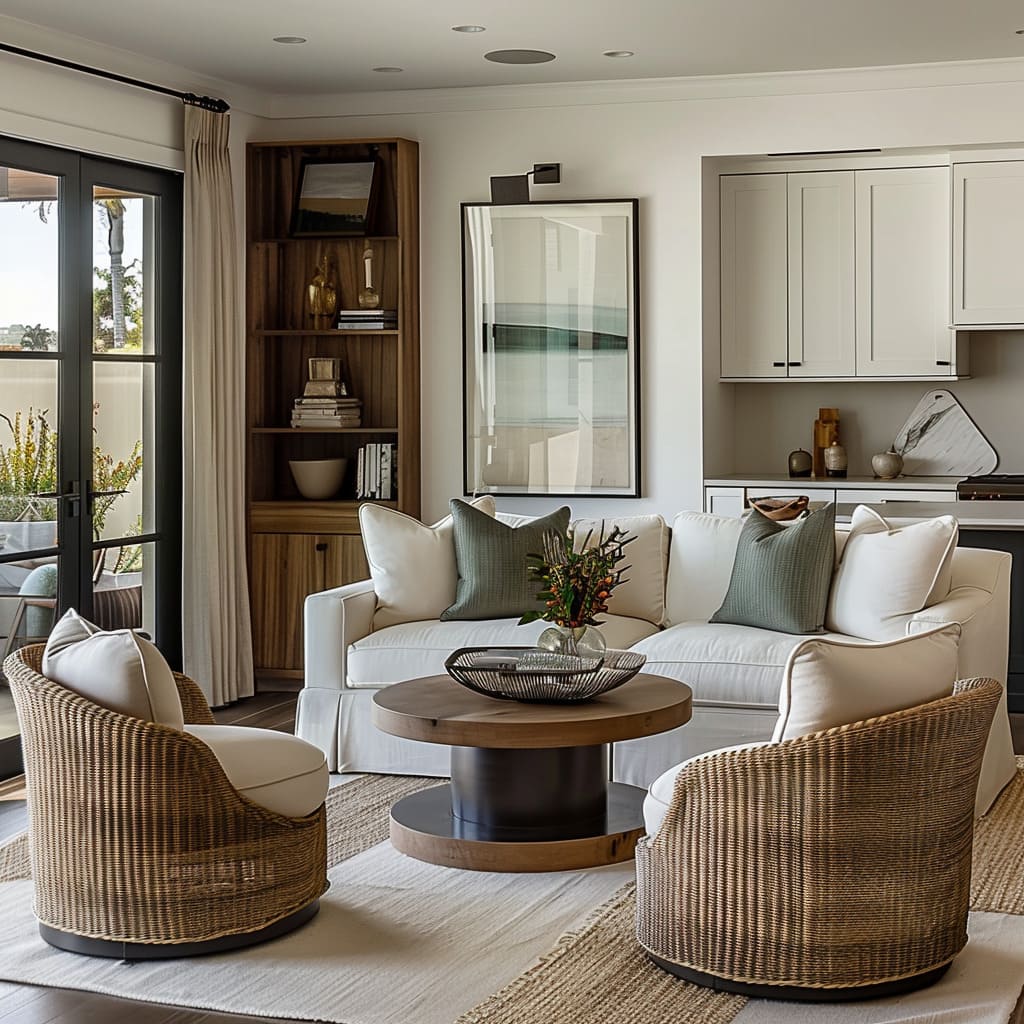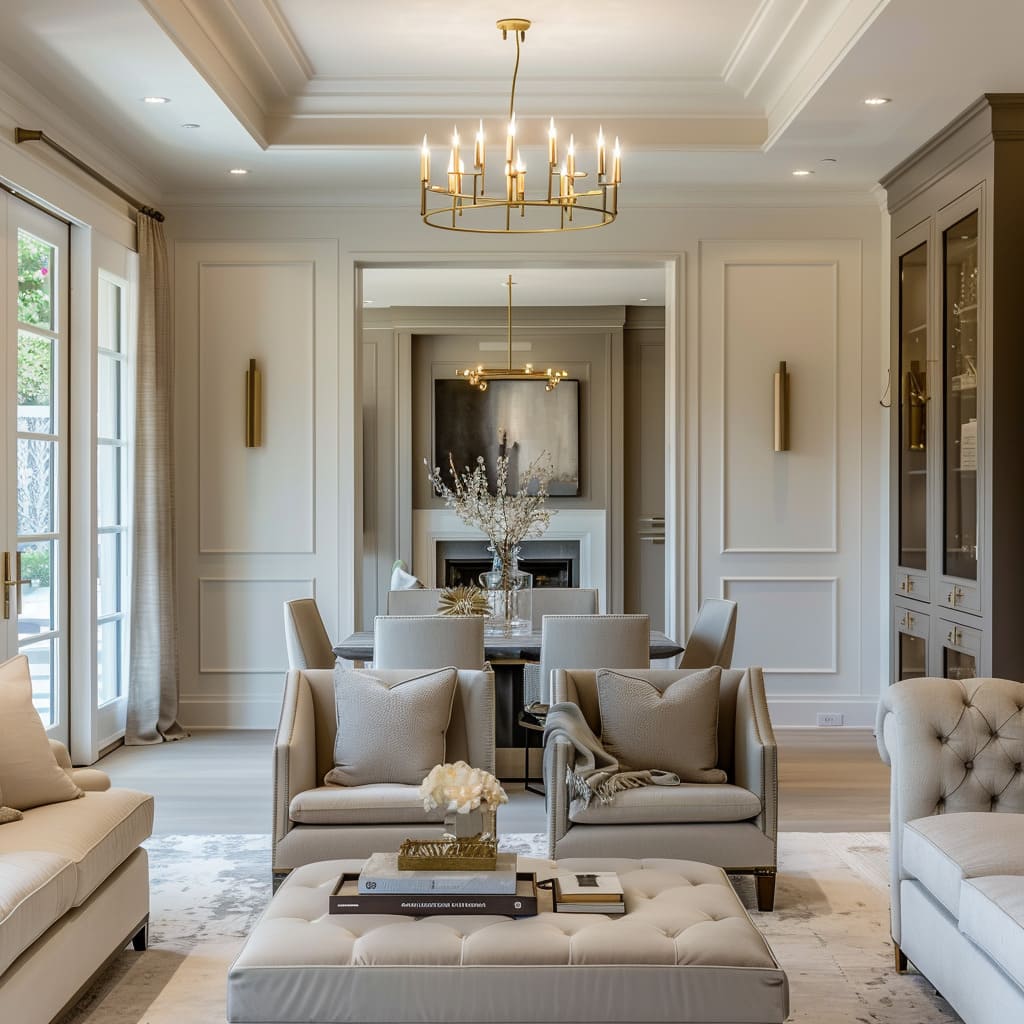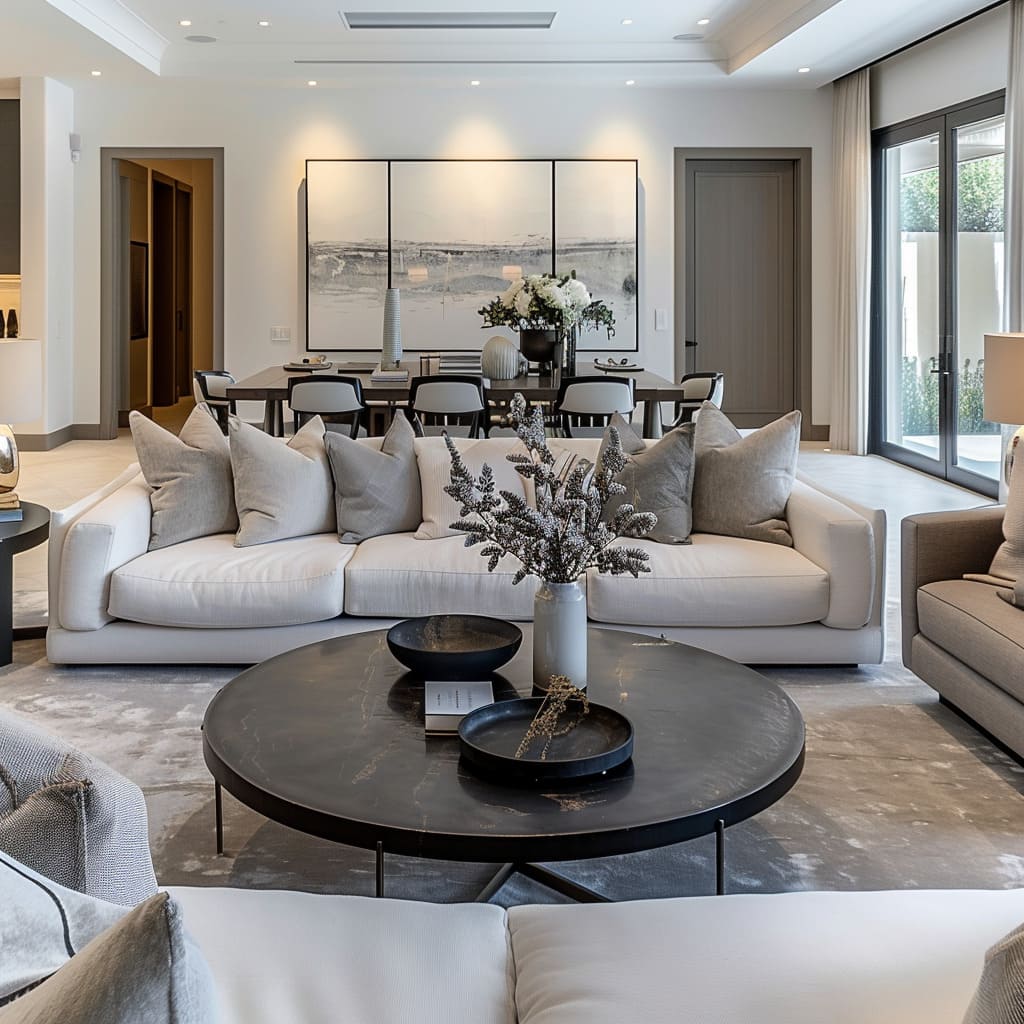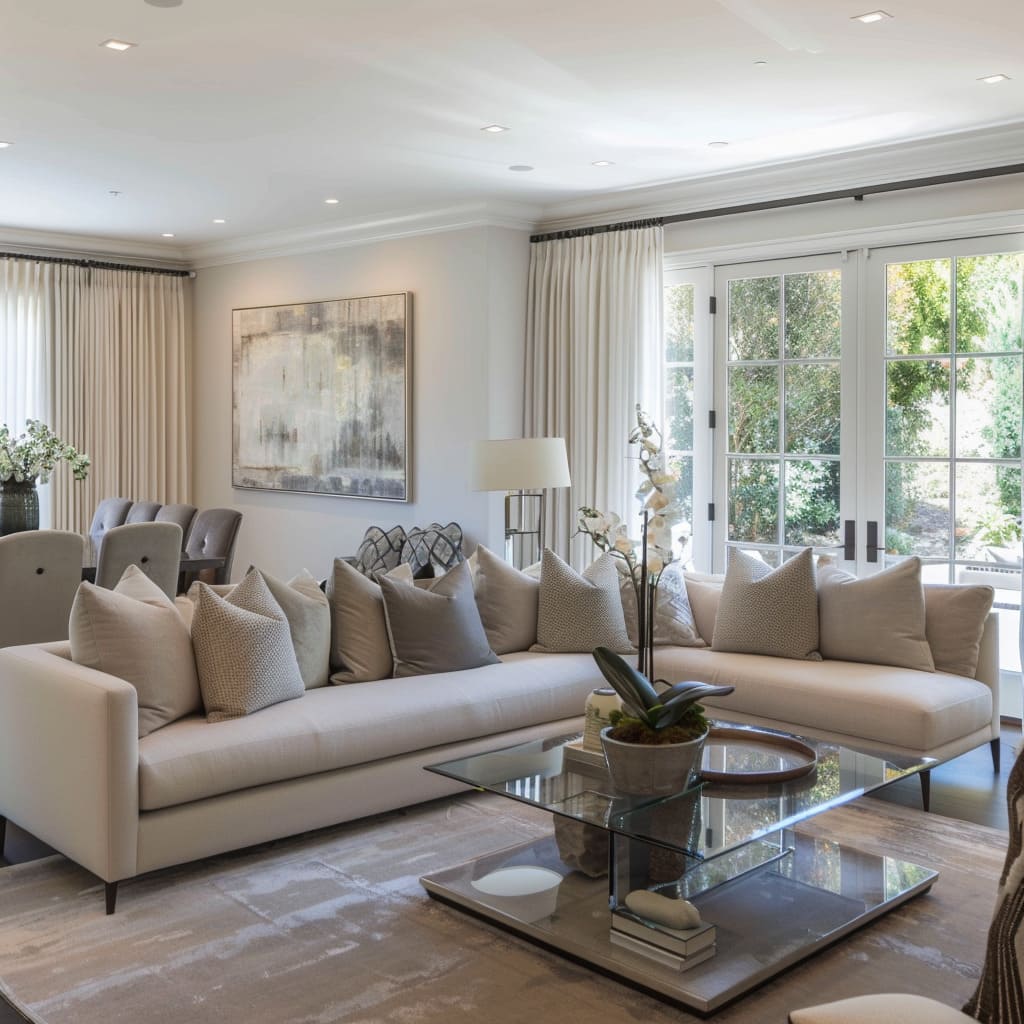Interior design transcends mere aesthetics to encompass the practical aspects of living spaces, ensuring they are not only visually appealing but also fully functional. Key elements such as storage, lighting, and flooring play significant roles in the optimization of both comfort and style.
This guide delves into each component, providing comprehensive insights and innovative solutions tailored to enhance modern living environments
Storage Solutions
Maximizing Space with Modern Cabinetry
Modern interior design often leans towards a minimalist ethos, where the beauty of clean, uncluttered spaces is paramount. Innovative cabinetry solutions are integral to achieving this look, utilizing sleek, handle-less designs that blend seamlessly into the walls.
The integration of such cabinetry not only optimizes the available space but also enhances the room’s aesthetics by creating a smooth, continuous look. For instance, kitchens can benefit greatly from cabinets that extend to the ceiling, offering ample storage while maintaining a tidy appearance
Open Shelving and Display Units
Open shelving is another dynamic storage solution that marries functionality with decor, allowing for the display of ornamental pieces alongside everyday items. This design choice encourages a balance between accessibility and visual appeal, where items are easily reachable yet attractively presented. It’s crucial to maintain a harmonious arrangement of items on open shelves to avoid a cluttered look, thus preserving the area’s sleek aesthetic.
Strategic placement of unique ceramics or books can transform these practical storage spaces into captivating focal points
Multi-Functional Furniture
In the realm of living areas, selecting furniture that serves multiple purposes can drastically enhance functionality without sacrificing space. Coffee tables with hidden storage compartments or ottomans that open up to reveal inner storage bins are perfect examples of smart furniture choices. These pieces not only provide necessary storage solutions but also contribute to a streamlined and organized living environment
How do the materials used for cabinetry in minimalist kitchens affect the overall longevity and maintenance requirements of the design?
In minimalist kitchen designs, the materials selected for cabinetry play a critical role in determining both the longevity and maintenance requirements of the space. Here are some insights based on the descriptions from our discussion about various kitchen interiors:
- Wood: Often favored for its warmth and natural aesthetic, wood can vary greatly in durability depending on the species. Hardwoods like oak, maple, and walnut are popular choices due to their resistance to wear and tear, making them ideal for long-lasting cabinetry.
However, wood requires regular maintenance to prevent damage from moisture and heat, common in kitchen environments.
They also tend to be more budget-friendly than solid wood and are available in a variety of finishes that can mimic the look of natural wood or even stone.
Wood cabinets should also be cleaned with gentle, non-abrasive cleaners to avoid scratching or damaging the finish.
Laminates are less susceptible to damage from water or heat, making them easier to maintain over time.
The longevity of kitchen cabinetry also depends on the construction quality and the installation process.
Even the best materials can fail if not properly installed or if the construction is poor. For example, solid wood might warp if not properly treated or if exposed to excessive humidity, whereas high-quality laminates could last many years without significant wear if well-maintained.
In conclusion, the choice of materials for cabinetry in minimalist kitchens significantly impacts the overall durability, maintenance needs, and long-term appearance of the space. Selecting the right material based on the specific needs and usage patterns of the household is essential to ensure that the kitchen remains both functional and beautiful over time.
In open shelving units, how does the choice of lighting enhance or diminish the display features, particularly in mixed-use spaces like the kitchen-living areas described?
The choice of lighting in open shelving units has a significant impact on how display features are highlighted or subdued, particularly in mixed-use spaces such as kitchen-living areas. In these environments, lighting not only serves practical purposes but also enhances aesthetic appeal, drawing attention to decorative elements and improving the overall ambiance.
Here’s how lighting choices can either enhance or diminish the display features in such settings:
Enhancement of Display Features
- Accent Lighting: Strategically placed accent lighting can dramatically enhance the appearance of items displayed on open shelving. By focusing light directly onto the shelves, accent lighting helps to highlight textures, colors, and details of the objects, making them stand out.
For instance, installing LED strip lights underneath each shelf or spotlighting from above can create a focal point that draws the eye, enhancing the visual appeal of decorative items such as ceramics, glassware, or books.
This approach ensures that the shelves are not just functional storage spaces but also key elements in the room’s design. For example, pendant lights over a kitchen island can provide task lighting for cooking while also casting a soft glow on adjacent open shelving, enhancing both the usability of the kitchen and the beauty of displayed items.
Adjusting the intensity or focus of the lighting can make a significant difference in how items are perceived, enabling the creation of different moods and atmospheres within the space depending on the time of day or the desired ambiance.
Diminishment of Display Features
- Poorly Positioned Lighting: If lighting is not properly planned, it can cast shadows on the open shelving or create glare, which diminishes the visibility and attractiveness of displayed items. For example, overhead lighting that is too harsh or directly above the shelving can create shadows underneath items, making details harder to see and reducing the overall aesthetic appeal.
- Overwhelming Brightness: Excessive brightness can wash out colors and textures, making items on open shelves appear flat and uninteresting.
In mixed-use spaces, it’s crucial to balance the intensity of light across different areas to ensure that no single space is over-illuminated, which can detract from the harmony and visual comfort of the area.
In conclusion, the careful selection and placement of lighting in relation to open shelving units are crucial for maximizing their potential as display features, especially in areas where living and cooking functions converge. Effective lighting enhances not only the functionality of these spaces but also their aesthetic richness, making each item on display a contributing part of the overall ambiance and style of the home
What are the ergonomic considerations in designing multi-functional furniture, such as the coffee tables and ottomans discussed, especially in compact living environments?
Ergonomic considerations are pivotal in designing multi-functional furniture, particularly in compact living environments where maximizing space and comfort is essential. For furniture like coffee tables and ottomans that serve multiple purposes, several ergonomic aspects need to be carefully considered:
Proportions and Scale
- Size and Height: The size and height of multi-functional furniture must be compatible with other furnishings in the room and should be tailored to the users’ needs. For example, a coffee table that also serves as a dining space in a small apartment should be at a comfortable height for eating (generally around 28-30 inches), while also functioning well at a lower height suitable for a typical coffee table (about 18-20 inches).
This ensures usability without causing discomfort during extended periods of use.
Accessibility and Usability
- Ease of Transformation: Multi-functional pieces often transform from one use to another, such as ottomans that open up to reveal storage or extend into a guest bed. The mechanisms involved should be easy to operate, requiring minimal effort and physical strain. This includes considerations like lightweight lids, smooth-operating hinges, and pull-out components that are easy to maneuver.
- Storage Access: For furniture with storage capabilities, the design must allow easy access to the contents.
This means considering the placement of handles, the angle of opening, and the depth of storage compartments to ensure that items can be reached comfortably without the need to excessively bend or stretch.
Comfort and Support
- Seating Comfort: If an ottoman or coffee table is to be used for seating, it needs to provide adequate support and comfort. This involves selecting the right cushioning materials that maintain their shape and offer support while being comfortable to sit on for prolonged periods. The surface material should also be durable and easy to clean, considering its multipurpose usage.
- Ergonomic Posture: When used as seating or dining surfaces, the furniture should promote a healthy posture.
This includes providing support to the lower back if used for sitting and ensuring that the height and depth are appropriate for the average user to sit comfortably without slouching or straining.
Material Considerations
- Durability and Maintenance: Materials chosen for multi-functional furniture must be durable enough to withstand various uses and easy to maintain, especially in compact spaces where every piece of furniture is likely used more frequently. For instance, surfaces should be resistant to scratches, stains, and moisture, especially for items like coffee tables that might also serve as dining tables.
Aesthetic Integration
- Visual Appeal: While ergonomics focuses on functionality and comfort, the aesthetic appeal cannot be overlooked. The furniture should not only be ergonomic but also visually pleasing, fitting seamlessly into the overall decor of the space. This helps ensure that the pieces do not look out of place or overly utilitarian, which can be challenging in small, stylish environments.
Incorporating these ergonomic considerations ensures that multi-functional furniture not only maximizes space in compact environments but also enhances comfort, usability, and overall living quality, making small spaces more livable and enjoyable
Lighting Essentials
Layering Ambient, Task, and Accent Lighting
A well-lit room utilizes a layered approach to lighting, combining ambient, task, and accent lighting to create an inviting atmosphere. Ambient lighting provides the overall light level, while task lighting focuses on specific areas to aid activities like reading or cooking. Accent lighting, however, is used to highlight architectural features or key decor elements.
Integrating these three types ensures a flexible lighting scheme that can adapt to various needs and times of the day, significantly enhancing the functionality and ambiance of any room.
Natural Light Utilization
Making the most of natural light not only saves energy but also brings the intrinsic beauty of daylight into a home, making spaces appear larger and more open. Thoughtful placement of windows and reflective surfaces can amplify this effect, bathing interiors in light and offering a natural warmth that can’t be replicated by artificial sources. Additionally, choosing the right window treatments can play a crucial role in controlling the amount of natural light entering a room, allowing for adjustments throughout the day to suit different activities
Decorative Lighting Fixtures
Choosing the right lighting fixtures can significantly influence a room’s aesthetic and atmosphere. A statement chandelier or uniquely designed pendant lights can act as art pieces, drawing the eye and adding layers of style and sophistication to any space. These fixtures not only illuminate but also serve as stunning decor elements that reflect personal style and enhance the overall design theme
How does the choice of pendant light designs over kitchen islands contribute to both task lighting and the aesthetic appeal in open-plan living spaces?
The choice of pendant light designs over kitchen islands plays a crucial role in enhancing both task lighting and aesthetic appeal, especially in open-plan living spaces. Here’s how:Task Lighting Efficiency Pendant lights are strategically positioned over kitchen islands to provide concentrated task lighting.
This is essential in a kitchen setting where precise, clear lighting is needed for cooking and preparation activities. The direct illumination from pendant lights ensures that the island is well-lit, reducing shadows and glare that might impede these tasks. This focused lighting is critical for safety and functionality, allowing for detailed work like chopping vegetables, measuring ingredients, or reading recipes without straining the eyes.
Aesthetic ContributionBeyond their functional role, pendant lights also serve as key design elements in open-plan living spaces. They act as visual anchors that help to define the kitchen area within the larger living space. The style, size, and color of the pendant lights can dramatically influence the space’s decor, contributing to the overall design theme.
For example, sleek, minimalist pendant designs can complement a modern decor, while ornate or industrial-style pendants might enhance a rustic or contemporary aesthetic, respectively.
Integration into Living Spaces In open-plan designs, the kitchen is not just a place for cooking but a central hub of home interaction, often visible from the living and dining areas. The pendant lights over the island can create a visual and atmospheric bridge between these areas. Elegant lighting not only draws attention to the kitchen island as a focal point but also helps to integrate the decor with that of the surrounding space, making the transition between functional zones feel seamless and thoughtfully curated.
Scale and Proportion Choosing the right pendant light involves considering the scale and proportion in relation to the kitchen island and the overall space. Large, bold pendants can make a dramatic statement and serve as art pieces, while smaller pendants might provide a subtler, more understated look. The spacing between lights, and the distance from the ceiling, also affects both the lighting effectiveness and the visual balance in the space.
Enhancing Ambiance The ambient effect of pendant lighting can transform the mood of the kitchen and adjacent living areas. Using dimmable pendant lights, for instance, allows for flexibility in adjusting the lighting to suit different times of day or occasions, from bright and functional during food preparation to softer and more ambient for social gatherings. Thus, the choice of pendant lights over a kitchen island is integral to both the functionality as task lighting and the enhancement of the interior aesthetic, playing a dual role that impacts both the practical and emotional resonance of the space.
In what ways do the integrated LED strip lights under kitchen cabinets impact the functionality of task areas and the overall ambiance of minimalist kitchen designs?
Integrated LED strip lights under kitchen cabinets significantly impact both the functionality of task areas and the overall ambiance of minimalist kitchen designs in several key ways: Enhancing Task Efficiency LED strip lights provide targeted illumination for countertops, making it easier to handle precision tasks such as chopping, mixing, or reading recipes. This focused lighting reduces shadows and glare that overhead lights might cast, especially when someone is standing directly at the counter.
By brightening work surfaces, these lights ensure that food preparation is safer and more efficient, crucial in any kitchen setup.
Minimalist Design Integration In minimalist kitchen designs, where the aesthetic is clean and uncluttered, integrated LED strip lights add to the sleek look without disrupting the visual flow. These lights are often hidden beneath the cabinetry, providing necessary lighting without visible fixtures that could detract from the minimalist style.
This subtle integration preserves the smooth lines and open feel that are hallmarks of minimalist design.
Creating Visual Depth LED strip lights can add depth to a kitchen design by illuminating the backsplash and countertop, which helps to separate the counter space visually from the cabinetry above. This effect not only enhances the perception of space within the kitchen but also highlights the quality of materials used in countertops and backsplashes, such as marble or granite, enhancing their natural beauty.
Ambient Influence Although primarily functional, LED strip lights also contribute to the overall ambiance of the kitchen. The warm or cool light emitted by these strips can set the mood of the space, making it feel warm and welcoming or crisp and energizing, depending on the chosen color temperature.
This ambient lighting is particularly effective in minimalist designs, where the play of light and shadow can define the space’s character.
Energy Efficiency LEDs are known for their energy efficiency and long lifespan, which makes them an ideal choice for kitchens where lights are often used for extended periods. This efficiency is especially beneficial in minimalist designs that value sustainability and simplicity, aligning with the broader goals of reducing waste and maximizing resources.
Versatility in Usage LED strip lights are versatile in their application, which allows them to be used not only under the cabinets but also along toe kicks or inside cabinetry. This flexibility means that lighting can be customized to meet the specific functional needs of different areas within the kitchen while maintaining a cohesive aesthetic throughout the space.
The integration of LED strip lights under kitchen cabinets thus plays a dual role, enhancing both the functionality and the ambiance of minimalist kitchen designs. These lights improve task efficiency, integrate seamlessly into minimalist aesthetics, add depth and character to the space, and contribute to an inviting atmosphere—all while being energy-efficient.
What role do adjustable lighting fixtures play in balancing the lighting needs in multi-use spaces, particularly in settings where living, dining, and kitchen areas are combined?
Adjustable lighting fixtures play a crucial role in balancing the lighting needs in multi-use spaces, especially in environments where living, dining, and kitchen areas are seamlessly combined. Here’s how they contribute to the functionality and ambiance of such spaces:
Flexibility in Lighting Control Adjustable fixtures, such as track lights, dimmable overhead lights, or lamps with adjustable arms, provide the flexibility to alter lighting levels and focus according to different activities and times of the day. This adaptability is essential in multi-use spaces where various activities, from cooking to dining to relaxing, may require different lighting intensities and directions. For example, brighter, more direct lighting is necessary for kitchen tasks, while softer, diffused lighting enhances the comfort of a living area.
Enhancing Functional Zoning In an open-plan layout, it’s important to define different zones visually and functionally. Adjustable lighting helps achieve this by allowing specific areas to be highlighted or subdued.
By adjusting the intensity or direction of light, distinct atmospheres can be created within the same physical space, making it possible to have a brightly lit kitchen area alongside a dimly lit dining area, which can help delineate these zones without the need for physical barriers.
Maintaining Aesthetic Cohesion Adjustable lighting fixtures can be designed to complement the decor throughout the space, maintaining aesthetic cohesion across the living, dining, and kitchen areas. The ability to adjust these fixtures means that they can serve both decorative and functional purposes, such as pendant lights over a dining table that can be dimmed for a dinner party or brightened for homework or other tasks.
Improving Energy Efficiency With the ability to adjust the intensity of lighting based on actual needs, energy consumption can be optimized, contributing to a more sustainable living environment. Dimmable LEDs, for instance, use less energy when dimmed, even as they provide adequate lighting for the task at hand. This is particularly valuable in multi-use spaces that are used throughout the day and evening.
Supporting Mood and Ambiance The mood in a multi-use space can significantly benefit from adjustable lighting. The capability to dim lights can transform an area from a bright and energetic space during meal preparation to a calm and cozy setting for evening relaxation. This versatility is key in creating a living space that adapts to the emotional and practical needs of its users throughout the day.
In summary, adjustable lighting fixtures are vital in multi-use spaces, offering the flexibility to change lighting levels and focus as needed. This adaptability not only enhances the functionality of each zone within the space but also contributes to a harmonious and dynamic environment, suitable for a variety of activities and settings.
Flooring Fundamentals
Choosing the Right Materials
Flooring is a crucial design element that sets the foundation for any interior. Materials such as hardwood, marble, and tile offer different aesthetics and practical benefits. For instance, hardwood brings warmth and classic appeal, while marble offers a touch of luxury and coolness underfoot, ideal for hotter climates.
Choosing the right flooring material depends on the room’s function, the local climate, and maintenance considerations, all of which influence both the style and longevity of the flooring.
Color and Texture in Flooring
The choice of color and texture in flooring can significantly affect the perception of space within a home. Lighter floors can make a room feel more spacious and airy, while darker tones add coziness and depth. Textured surfaces such as distressed wood or patterned tile can add character and interest, anchoring the decor and complementing the overall design narrative
Rugs and Carpets
Beyond hard flooring, rugs and carpets play a key role in defining areas within larger spaces, adding layers of warmth, comfort, and sound insulation. The right rug can tie together various elements of a room, creating a cohesive look while also serving practical functions such as noise reduction and warmth.
Conclusion Incorporating thoughtful storage, strategic lighting, and appropriate flooring choices can transform any space into a functional and inviting environment. This guide not only offers practical solutions but also inspires creativity, encouraging homeowners to think critically about how each element affects the functionality and aesthetic of their living spaces.












































